Southwest spice blends work perfectly with sunbaked recipes because they're designed to enhance flavors that develop under intense heat. You'll find that core spices like chili powder, cumin, and smoked paprika intensify naturally when exposed to the sun's rays, which are particularly strong in the Southwest region. These blends also help lock in moisture during slow cooking processes while creating complex flavor layers that complement traditional outdoor cooking methods. When you combine these aromatic spices with solar cooking techniques, you'll get ideal heat retention and superior taste development. Discover how these time-tested combinations can transform your outdoor cooking experience.
Benefits of Solar Heat Distribution
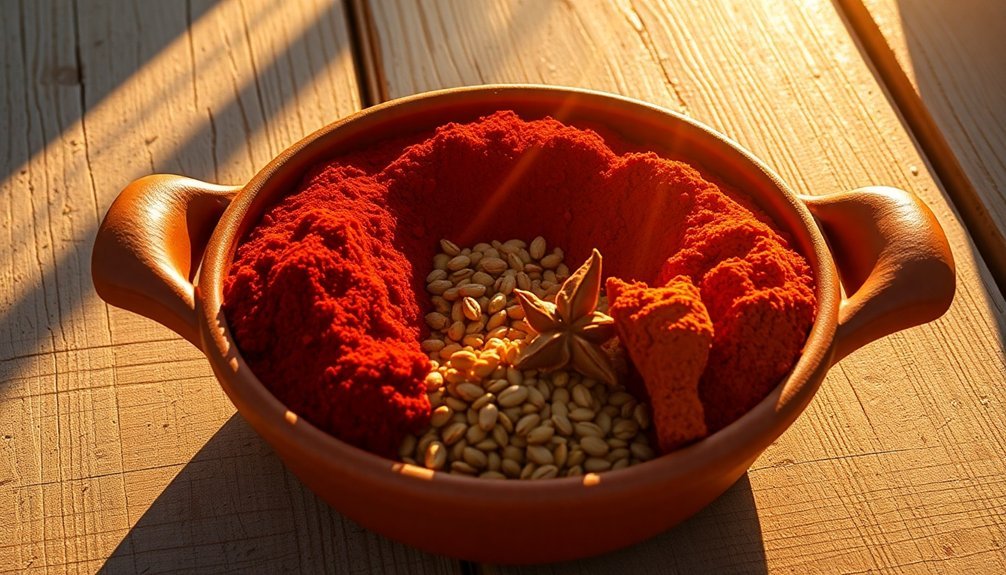
While many regions struggle to harness solar energy effectively, the southwestern United States enjoys unparalleled advantages in solar heat distribution. You'll find up to twice the solar radiation here compared to other parts of the country, making it ideal for solar cooking techniques.
The consistent sunlight you get in the Southwest enables efficient heat generation through various solar cooking methods. You can rely on parabolic and Scheffler cookers to concentrate sunlight for high-temperature cooking, while box cookers retain heat effectively through the greenhouse effect. This region often sees fuel savings of 30-40% annually compared to traditional cooking methods.
The region's abundant solar energy means you'll achieve better results with thermal receivers and reflective materials. Whether you're using direct or scattered sunlight, you'll benefit from the Southwest's superior solar conditions, making it possible to cook a wide variety of dishes consistently.
Essential Southwest Spice Components
Moving from harnessing the Southwest's abundant sunlight to capturing its signature flavors, mastering the right spice blend will transform your Southwestern cooking.
You'll need core spices like chili powder, cumin, and smoked paprika to create that authentic taste profile, while garlic and oregano provide essential depth. The blend delivers a smoky flavor profile that perfectly complements various dishes.
- Start with heat-building elements like cayenne and chipotle powder, adjusting levels to your preference.
- Layer in complexity with onion powder, coriander, and Mexican oregano.
- Fine-tune your blend by customizing ratios and experimenting with substitutions.
Don't forget that your homemade Southwest blend isn't just for tacos – it's perfect for beans, soups, and grilled meats.
Store your creation in an airtight container, and you'll have instant Southwest flavor at your fingertips for up to six months.
Slow Cooking Flavor Development
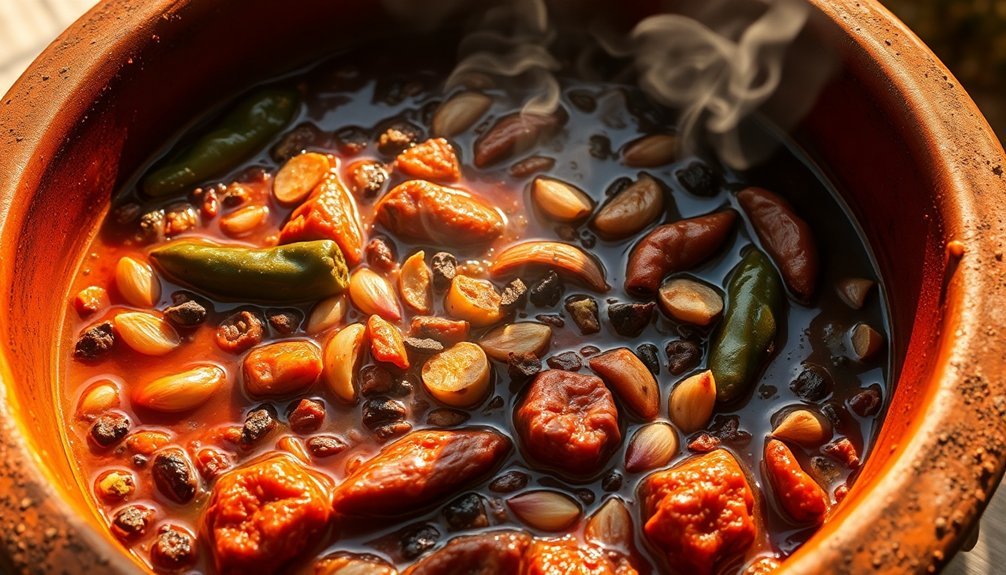
To maximize flavor in Southwest cooking, mastering slow-cooking techniques transforms simple ingredients into rich, complex dishes. You'll need to brown your aromatics, meats, and vegetables first, then deglaze the pan with stock or wine to capture every flavorful bit. Keep your liquid levels minimal, adding just 1-1½ cups to account for moisture released during cooking. Low-sodium stock provides an excellent flavor base while letting you control salt levels.
| Technique | Key Action |
|---|---|
| Browning | Sauté aromatics and meat before slow cooking |
| Liquid Control | Use less liquid than recipes suggest |
| Spice Timing | Double spices, add fresh herbs at the end |
| Temperature | Maintain 185-205°F consistent simmer |
| Heat Distribution | Use heavy-bottomed pot with slight lid gap |
For the boldest Southwest flavors, you'll want to double your spices and maintain a gentle simmer throughout cooking. Remember to add fresh herbs near the end for brightness, and don't hesitate to reduce excess liquid if needed.
Moisture Retention With Spices
Your Southwest spice blends work perfectly with slow-cooking methods that lock in natural juices during the cooking process.
When you combine these aromatic spices with proper cooking techniques, you'll notice they help maintain moisture while adding complex layers of flavor to your dishes. Just as spices enhance depth in traditional baking, they work similarly in slow-cooked Southwest recipes.
The slow, even heat allows your spices to fully develop their flavors while keeping all the natural moisture sealed within your ingredients.
Natural Juices Stay Locked
While creating flavorful Southwest blends, preserving natural juices is essential for maintaining moisture in your dishes.
You'll find that incorporating natural juice-rich ingredients like pineapple and mango helps lock in moisture during cooking, while adding anti-inflammatory components like ginger and lemon peel enhances both flavor and preservation.
- Mix vegetables like cucumber and celery with your preferred fruits to create a balanced juice blend that won't overpower your Southwest seasonings.
- Use the freezing/thawing method to concentrate your juices before adding them to marinades or sauces.
- Add leafy greens like parsley not just for flavor, but for their natural moisture-retaining properties.
Remember to strain your juices if you're using them in marinades to guarantee even distribution throughout your dish.
Spices Prevent Moisture Loss
Building on the importance of natural juice retention, proper spice usage plays a key role in maintaining moisture throughout the cooking process.
When you're creating Southwest blends, you'll want to select spices that complement moisture retention while avoiding clumping issues that can affect your dish's texture and flavor distribution.
To maximize your blend's effectiveness, store your spices in airtight containers away from heat sources and steam. You can add a grain of rice or silica gel pack to your spice containers to combat moisture absorption.
When cooking, don't shake spices directly over steaming pots, as this introduces unwanted moisture that can cause clumping. Instead, measure your spices away from the heat and consider using anti-caking agents in your blends to maintain consistent texture and guarantee even distribution throughout your sunbaked recipes.
Slow-Cook Enhances Flavors
Because slow cooking naturally preserves moisture, it creates the perfect environment for spices to release their full potential. When you're cooking Southwest dishes, the low-and-slow method allows complex flavors to develop and meld together through the Maillard reaction, which occurs between 140°F and 165°F.
- Sear your proteins and vegetables first to create a caramelized crust and develop rich, browned bits that'll enhance your dish's depth.
- Add fresh herbs during the final cooking stages to maintain their vibrant flavors.
- Use broth instead of water as your cooking liquid to create an additional layer of Southwestern complexity.
You'll want to be strategic with your seasonings – start with a light hand on salt and pepper, then adjust to taste near the end of cooking. This approach guarantees your Southwest spices shine through without overpowering the dish.
Traditional Southwest Cooking Methods
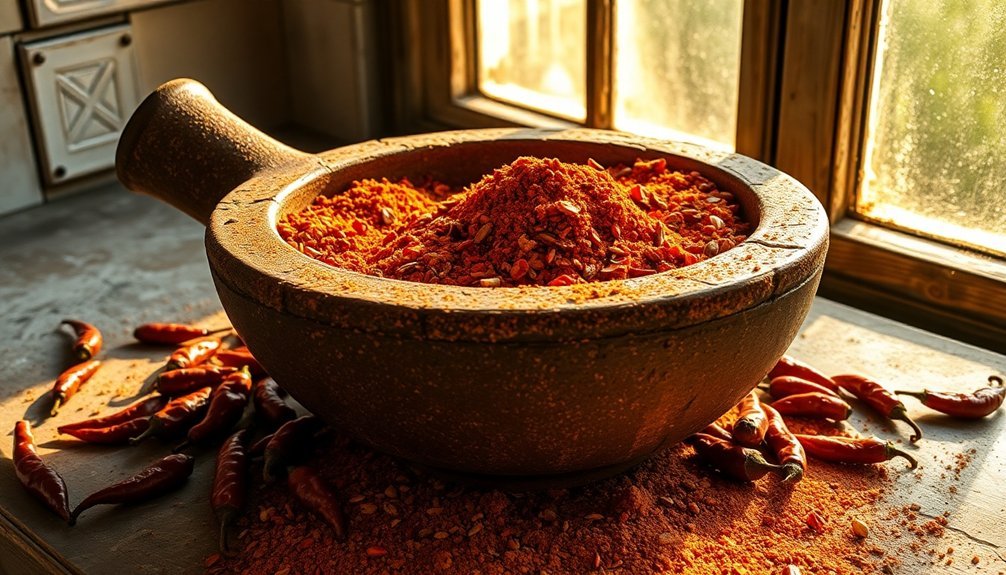
The heart of Southwestern cooking lies in its time-honored methods that blend Native American, Spanish, and cowboy traditions.
You'll find these techniques deeply rooted in the region's culinary DNA, from flame-roasting chilies to slow-cooking in clay pottery.
When you're cooking Southwest style, you'll want to embrace methods like adobo marinating, which infuses meats with complex flavors from chilies and spices.
Cast iron cooking, a staple of chuck wagon culture, adds distinctive flavors to everything from cornbread to grilled meats.
For authentic results, try roasting ingredients over mesquite wood, which imparts that signature smoky flavor you can't get any other way.
Don't forget traditional clay pottery cooking – it's perfect for stews and creates dishes free from metallic overtones.
Customizing Heat Levels
Your Southwest seasoning blend can strike the perfect balance between sweet and spicy elements by adjusting ingredients like cayenne pepper and chipotle powder.
You'll find that starting with smaller amounts of heat-bringing spices allows you to build up to your preferred spice level while maintaining the blend's essential flavors.
Whether you prefer a mild kick or intense heat, you can customize your blend by gradually increasing spicy components while taste-testing along the way.
Balancing Sweet And Heat
Creating perfect Southwest blends requires mastering the delicate balance between sweet and heat elements. You'll find this equilibrium by combining sweet and smoked paprika with carefully measured amounts of cayenne or chipotle peppers. These foundational ingredients create a harmonious blend that won't overwhelm your palate.
- Start with a base of smoked paprika and sweet paprika for depth.
- Add cayenne pepper incrementally to control heat levels.
- Incorporate chipotle for a smoky-sweet finish.
You can fine-tune your blend by adjusting the ratios of chili powder and other peppers like jalapeños or habaneros.
Don't forget to enhance the complexity with garlic powder, onion powder, and dried oregano. These aromatics complement the heat while maintaining the signature Southwest flavor profile you're aiming to achieve.
Personal Spice Preferences
Mastering personal spice preferences starts with understanding how different peppers contribute to your ideal heat level.
You'll find jalapeños offer versatile heat for everyday cooking, while habaneros pack intense spiciness for those craving extra fire. For milder options, poblanos deliver subtle warmth perfect for breakfast dishes and enchiladas.
You can easily customize your heat levels by adjusting pepper ratios and preparation methods. Remove seeds and membranes to reduce spiciness, or combine different peppers to achieve your perfect balance.
Start with a mild base like paprika, then build complexity by adding cumin, garlic powder, and smoked paprika. Don't forget to experiment with herbs like thyme and oregano to create depth.
Store your personalized blends in airtight containers, and you'll always have your preferred heat level ready.
Solar Temperature Control Techniques
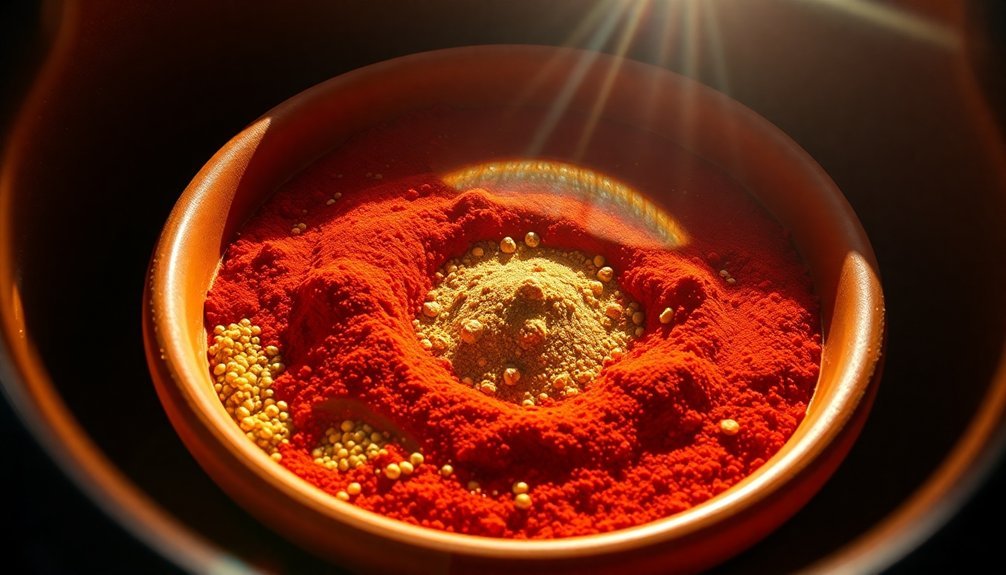
While solar panels thrive in sunlight, excessive heat can considerably reduce their efficiency and power output. You'll find several effective cooling techniques that help maintain ideal operating temperatures and maximize energy production.
- Reflective coatings and heat sinks can lower panel temperatures by up to 5°C, boosting power generation by 8% during peak hours.
- Elevated mounting systems with proper airflow can reduce temperatures by 2-4°C and increase annual energy yield by 5%.
- Water cooling systems, particularly effective in arid regions, can decrease panel temperatures by 10-20°C and improve production by 15%.
You're not limited to just one approach – combining these methods through integrated cooling technologies like PVT systems or nanofluids can enhance overall performance, especially in challenging climate conditions where heat management is essential.
Batch Preparation and Storage
Much like managing solar panel temperatures, proper preparation and storage of Southwest spice blends requires careful attention to detail. You'll want to measure and mix your spices precisely, keeping detailed records of ratios to guarantee consistency in future batches. Scale your recipes up or down while maintaining proportions, and customize the blend to match your heat and flavor preferences.
| Storage Tips | Environment | Duration |
|---|---|---|
| Airtight containers | Cool, dry place | Up to 6 months |
| Glass or plastic jars | Away from sunlight | Check monthly |
| Wide-mouth vessels | Pantry or cabinet | Label with date |
Store your blends in clean, dry containers and keep them away from heat sources and moisture. You'll get the most from your spice blend by organizing your storage space efficiently and following the first-in, first-out principle for maximum freshness.
Southwest Spice Pairing Guide
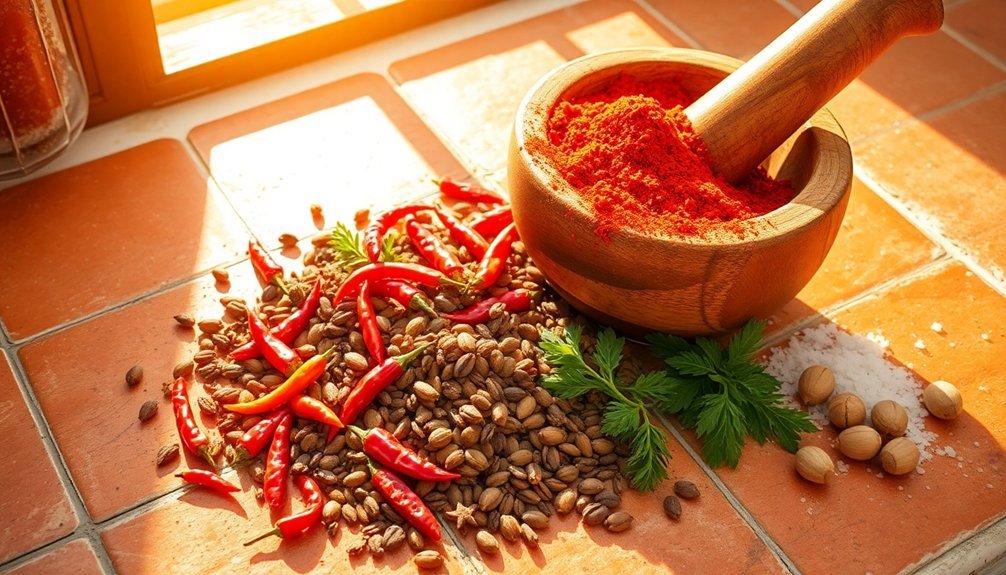
When you're working with proteins in Southwest cooking, you'll find that bold spices like cumin and chipotle powder create a robust foundation for your dishes.
Fresh herbs such as oregano can balance the intensity of these spices while adding complexity to your seasoning blend.
You can adjust the heat level by incorporating different chili powders and red pepper flakes, allowing you to customize the perfect spice combination for your taste preferences.
Proteins With Bold Spices
Mastering the art of Southwest spice pairings can transform ordinary proteins into bold, flavorful dishes.
You'll discover how each protein type pairs perfectly with specific spice combinations to create authentic Southwestern flavors.
- For meats, combine chili powder, smoked paprika, and ground cumin to create a rich, earthy base that's perfect for beef and pork.
- With poultry, you'll want to blend chili powder and cumin, while adding Mexican oregano for a fresh, aromatic touch.
- Fish and seafood shine when you use lighter combinations of smoked paprika and garlic powder.
Whether you're cooking meat, poultry, fish, or plant-based proteins, you can't go wrong with garlic and onion powder as your foundation.
For extra heat, simply add cayenne or chipotle powder to your desired spice level.
Fresh Herbs Meet Heat
Building on our protein pairings, fresh herbs bring another dimension to Southwest spice blends when combined with heat elements.
While basil and thyme aren't traditional Southwest ingredients, oregano and cilantro play starring roles in these aromatic mixtures. Mexican oregano, in particular, adds an earthy depth that perfectly complements the blend's smoky elements.
You'll find that dried cilantro offers pantry stability while maintaining its distinctive citrusy notes, especially when paired with chipotle powder or smoked paprika.
When you're crafting your blend, start with these herbs as your foundation, then layer in heat elements like chili powder or cayenne to achieve your desired spiciness.
For an extra burst of brightness, consider adding dried lemon zest, which balances the blend's warmer notes.
Seasonal Solar Cooking Adaptations
To maintain consistent cooking performance throughout the year, your solar cooker needs specific adjustments based on seasonal changes in the sun's elevation.
You'll need to adapt between two positions: the first handles 0º to 50º elevations, while the second manages 40º to 90º elevations.
For ideal Southwest cooking results in any season, focus on these key adjustments:
- Track the sun every 15 minutes using a Sunsight device for perfect alignment.
- Position your cooker slightly ahead of the sun's path to maintain continuous heat.
- Protect your setup from strong winds while ensuring clear exposure to sunlight.
During winter, you'll notice longer preheating times, but don't worry – once heated, your cooking times will stay consistent.
Take advantage of winter's thinner air and snow reflection, which can actually intensify sunlight and improve cooking efficiency.
Health Benefits While Sunbaking
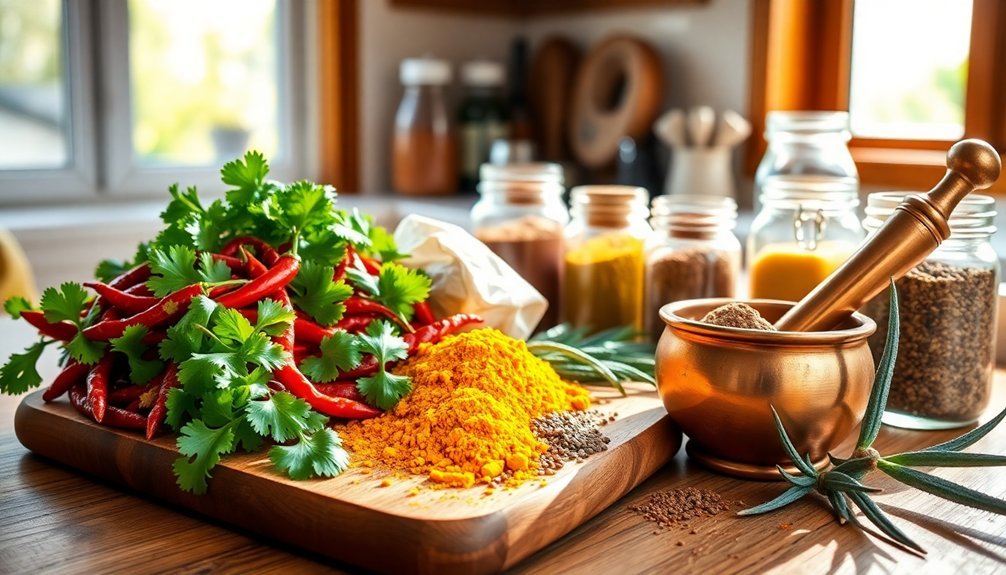
While solar cooking provides delicious meals, it also offers remarkable health benefits through sunlight exposure. As you prepare your Southwest blends outdoors, you'll get vitamin D naturally, which strengthens your bones and supports your immune system.
The sunlight you receive during cooking helps regulate blood pressure and enhance brain function. You'll notice improved mood and mental clarity while solar cooking, thanks to increased serotonin levels from sun exposure.
The UV rays also assist in fighting infections and treating various skin conditions. While monitoring your dishes, you're benefiting from the sun's ability to help regulate blood sugar levels and maintain healthy blood vessels.
This makes outdoor cooking with Southwest blends not just a culinary adventure, but also a boost to your overall well-being.
Enhancing Natural Food Flavors
Southwest spice blends transform ordinary ingredients into vibrant, flavorful dishes by amplifying their natural tastes.
You'll find chili powder and smoked paprika create the signature base, while garlic and onion powder add depth to every bite.
When you're crafting these blends, remember that balance is key – salt enhances the overall profile while helping you control heat levels.
- Create depth by combining smoky chipotle with traditional chili powder
- Adjust heat levels by varying the ratio of black pepper and chili powders
- Enhance flavors with citrus and herbs for bright, complex notes
You can adapt these blends for various cooking methods, from grilling to slow cooking.
They're especially effective when paired with beans, rice, or fresh vegetables, and they'll elevate your guacamole with just a small amount.
Frequently Asked Questions
Can Southwest Blends Be Used With Other Alternative Cooking Methods Besides Solar?
Yes, you'll find Southwest blends work great with various cooking methods. You can use them effectively on open fires, wood-burning stoves, propane grills, and charcoal stoves for delicious, flavorful results.
How Long Do Homemade Southwest Spice Blends Stay Fresh in Different Climates?
In cool, dry climates, your homemade southwest blends will last up to 6 months. You'll need to reduce storage time to 3-4 months in humid areas, unless you're using airtight containers in climate-controlled spaces.
Are There Specific Utensils Recommended for Applying Southwest Blends in Solar Cooking?
You'll want dark-colored enamel or thin metal pots with tight lids when applying southwest blends in solar cooking. Use non-reflective utensils and wooden spoons to prevent scratching while ensuring even spice distribution.
Do Southwest Blends React Differently With Ceramic Versus Metal Solar Cookware?
You'll find Southwest blends perform better in ceramic solar cookware since it's non-reactive and won't alter flavors. Metal cookware can react with acidic spices, potentially affecting taste and causing unwanted metallic notes.
What Time of Day Yields the Best Results When Solar Cooking With Southwest Blends?
You'll get best results cooking Southwest blends between 11:00 AM and 2:00 PM, when the sun's directly overhead. These spices release their flavors best during peak solar hours with maximum heat intensity.
In Summary
You've discovered how Southwest blends excel in sunbaked dishes by distributing heat evenly while intensifying natural flavors. These spices don't just add warmth – they help seal in moisture and develop complex tastes during slow solar cooking. Whether you're grilling outdoors or using traditional methods, you'll find these blends work perfectly with the sun's natural heat to create authentic Southwestern dishes packed with flavor and nutrition.

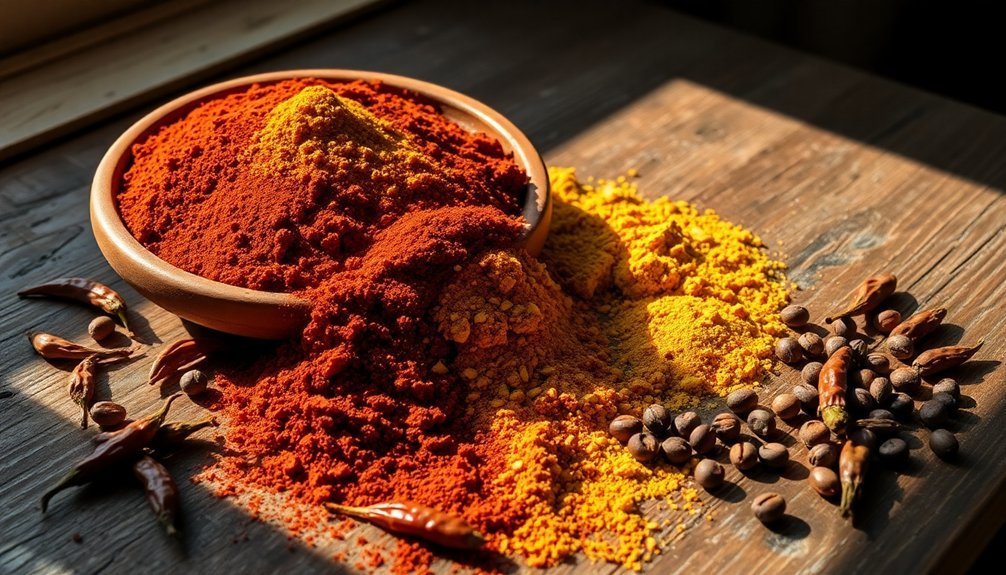



Leave a Reply